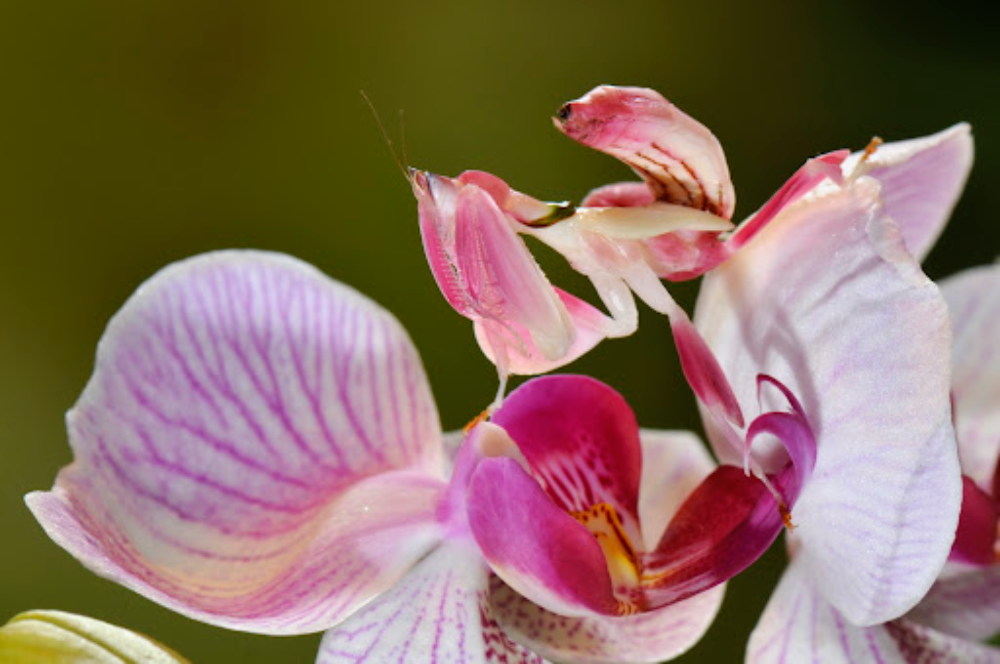The Orchid Mantis (Hymenopus coronatus) is one of nature’s most captivating and enigmatic creatures. Known for its stunning resemblance to orchid flowers, this insect is a marvel of evolutionary adaptation, blending beauty with predatory prowess. Native to the rainforests of Southeast Asia, the Orchid Mantis has fascinated scientists and nature enthusiasts alike. This article delves into the biology, behavior, and ecological significance of this remarkable mantis, exploring its unique adaptations and the role it plays in its environment.
Biological Overview
The Orchid Mantis is renowned for its striking appearance, which mimics the delicate petals of an orchid flower. This mimicry is not merely superficial; every aspect of its body has evolved to enhance this illusion. The mantis’s legs resemble flower petals, complete with varying shades of pink and white that match the natural hues of orchids. This camouflage serves a dual purpose: it aids in ambush predation and protects the mantis from potential predators.
Adult Orchid Mantises can reach lengths of up to 6-7 centimeters. Females are generally larger than males, a common trait among mantids. Their bodies are adorned with lobes that enhance their flower-like appearance, and their coloration can change slightly depending on their environment and diet, allowing for better integration with their surroundings.

Life Cycle and Reproduction
The life cycle of the Orchid Mantis consists of three main stages: egg, nymph, and adult. Females lay their eggs in a foam-like case called an ootheca, which hardens to protect the developing embryos. Once hatched, the nymphs resemble tiny versions of the adults but without fully developed wings. These nymphs go through several molts, shedding their exoskeletons as they grow.
Mating in Orchid Mantises can be perilous for males, as females are known to exhibit sexual cannibalism. This behavior, while seemingly brutal, may provide nutritional benefits to the female, aiding in egg production. Males approach females cautiously, often waiting until the female is well-fed before attempting to mate.
Behavior and Ecology
Orchid Mantises are sit-and-wait predators, relying on their camouflage to ambush prey. Their primary diet consists of other insects, particularly pollinators like bees and butterflies that are attracted to flowers. When an unsuspecting insect comes close, the mantis strikes with lightning speed, capturing its prey with powerful, spiked forelegs.
This predatory strategy is highly efficient, as the mantis’s flower-like appearance lures prey directly into its reach. Studies have shown that Orchid Mantises are particularly successful in environments where real flowers are abundant, as their disguise is most effective when surrounded by actual blossoms.
Habitat and Distribution
The natural habitat of the Orchid Mantis spans the tropical rainforests of Southeast Asia, including Malaysia, Indonesia, Thailand, and Myanmar. These regions provide the warm, humid conditions that the mantis needs to thrive. In the wild, Orchid Mantises are often found in flowering plants and shrubs, where their camouflage offers the best protection and hunting opportunities.
Human activities, such as deforestation and habitat destruction, pose significant threats to the Orchid Mantis. Conservation efforts are essential to preserve the natural environments that support these and many other unique species.
Evolutionary Adaptations
The most remarkable adaptation of the Orchid Mantis is its mimicry of orchid flowers. This form of camouflage, known as aggressive mimicry, is used to deceive prey rather than predators. The mantis’s ability to imitate the appearance of a flower is an evolutionary marvel, involving intricate modifications to its body shape, coloration, and behavior.
Research suggests that the mantis’s mimicry is not limited to visual deception. Some studies indicate that Orchid Mantises may also emit scents that mimic those of real flowers, further enhancing their ability to attract prey. This multi-sensory approach to mimicry underscores the complexity of their evolutionary adaptations.
In addition to their predatory adaptations, Orchid Mantises possess several defensive mechanisms to evade predators. Their primary defense is their camouflage, which makes them difficult to spot. When threatened, some Orchid Mantises adopt a deimatic display, spreading their legs and wings to appear larger and more intimidating. This display can startle potential predators, giving the mantis a chance to escape.
Ecological Significance
Orchid Mantises play a crucial role in their ecosystems as both predators and prey. By controlling populations of pollinating insects, they contribute to the balance of their ecological communities. Their presence also supports the biodiversity of their habitats, as their predatory activities can influence the distribution and behavior of other species.
Conservation Concerns
The Orchid Mantis faces several conservation challenges, primarily due to habitat loss. The deforestation of Southeast Asian rainforests for agriculture and urban development threatens the delicate balance of these ecosystems. Conservation efforts aimed at protecting natural habitats are vital for the survival of the Orchid Mantis and countless other species that depend on these environments.
Conclusion
The Orchid Mantis stands as a testament to the wonders of natural selection and evolutionary adaptation. Its exquisite mimicry of orchid flowers highlights the intricate relationships between organisms and their environments. As we continue to explore and understand these fascinating creatures, it becomes increasingly clear that their preservation is not only essential for maintaining biodiversity but also for appreciating the extraordinary complexity of life on Earth. By protecting the habitats that sustain the Orchid Mantis, we ensure that future generations can marvel at this remarkable example of nature’s ingenuity.









